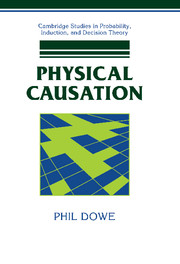Book contents
- Frontmatter
- Contents
- Acknowledgements
- 1 Horses for Courses: Causation and the Task of Philosophy
- 2 Hume's Legacy: Regularity, Counterfactual and Probabilistic Theories of Causation
- 3 Transference Theories of Causation
- 4 Process Theories of Causation
- 5 The Conserved Quantity Theory
- 6 Prevention and Omission
- 7 Connecting Causes and Effects
- 8 The Direction of Causation and Backwards-in-Time Causation
- References
- Index
8 - The Direction of Causation and Backwards-in-Time Causation
Published online by Cambridge University Press: 13 October 2009
- Frontmatter
- Contents
- Acknowledgements
- 1 Horses for Courses: Causation and the Task of Philosophy
- 2 Hume's Legacy: Regularity, Counterfactual and Probabilistic Theories of Causation
- 3 Transference Theories of Causation
- 4 Process Theories of Causation
- 5 The Conserved Quantity Theory
- 6 Prevention and Omission
- 7 Connecting Causes and Effects
- 8 The Direction of Causation and Backwards-in-Time Causation
- References
- Index
Summary
I have claimed that it is profitable to distinguish three key questions about causation. The first question, what are causal processes and interactions?, was addressed in Chapter 5. The second question, what is the connection between causes and effects?, was addressed in Chapter 7.The third question, what makes a cause different from an effect?, has not been addressed, and it is to that task that we turn in the present chapter.
The question of the directionality and asymmetry of causation has long been an important ingredient in philosophical discussions of causation, although perhaps Reichenbach (1991) was the first to truly appreciate the significance of the question. It is certainly an aspect of folk intuitions. Many philosophers have held that an adequate analysis of causality should provide an explanation or account of causal asymmetry. On the other hand, it is precisely this aspect of causation that is the most common target for elimination from empirical accounts. This chapter looks at the ability of 'process' theories of causality to provide such an account, granting certain constraints.
The major constraint, or premise, in the following analysis is the assumption that quantum mechanics reveals the presence of backwards-in-time causation. Thus, in the first instance, the argument presented here will not convince those who hold that there can be no backwards causation. However, I derive an empirical prediction, which, if confirmed, would give those sceptical about backwards causation reason to think again.
The chapter begins with an analysis of some of the formal properties of causation. This is followed by a nontechnical presentation of the famous difficulties associated with Bell phenomena in quantum mechanics, and the backwards-in-time solution to those difficulties.
- Type
- Chapter
- Information
- Physical Causation , pp. 176 - 210Publisher: Cambridge University PressPrint publication year: 2000



